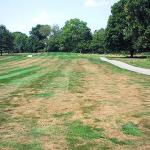Gray Leaf Spot of Ryegrass and Tall Fescue
Gray leaf spot is caused by the fungi Pyricularia grisea and P. oryzae, both of which are members of the Magnaporthe grisea species complex. In recent years, significant outbreaks of this disease have occurred on ryegrasses and tall fescues in the Northeast. Gray leaf spot is most often seen in late summer and early fall in this area on higher cut ryegrass and tall fescues in roughs, athletic fields, and lawns. The pathogen also attacks many genera of warm season turfgrass.
Symptoms may resemble drought or heat stress. Foliar symptoms first appear as small, water-soaked lesions which become necrotic. Lesions can vary in color, size, and shape, but are most often gray to light brown with a dark brown border. Older lesions are sometimes surrounded by a yellow halo. Lesions may coalesce into irregular shapes and cause complete blighting of individual blades. Blighted leaves may be twisted into a characteristic "fish-hook" shape and covered with grayish conidia (spores) and conidiophores. Infected patches may remain small, but if the environmental conditions are favorable they may expand into large, irregularly shaped necrotic areas. Disease can develop rapidly under hot, humid conditions.
Pyricularia may survive unfavorable periods as dormant mycelium in infested leaves and plant debris; however, outbreaks in the northeast are believed to be initiated by conidia carried on southerly air currents. Once infection is established, abundant conidia are produced under warm, humid conditions and spread by wind, water, and equipment to start new infections. This cycle will continue as long as environmental conditions are conducive. The optimal temperature for disease development is 82-90 °F and epidemics may continue into October, subsiding after a heavy frost. Leaf wetness is also a critical factor in epidemic development. Gray leaf spot is most serious in newly established plantings, in the shade, and on higher cut turf. Disease severity increases with nitrogen levels: water-soluble sources of nitrogen promote both rapid growth and disease development. Other stress factors such as herbicides, plant growth regulators, soil compaction, and drought may predispose the turf to gray leaf spot.
Cultural Management
- Minimize periods of leaf wetness by watering before mid-day. Water deeply and infrequently, avoiding moisture stress.
- Prune trees and shrubs to reduce shade and improve light penetration and air circulation.
- Avoid excessive nitrogen fertility. Keeping nitrogen fertility low (0.5 lb N/1000 sq ft) during the summer months reduces turgrass susceptibility. Slow release forms of nitrogen do not stimulate disease development.
- On golf courses, monitor roughs where disease is most likely to start.
- Where gray leaf spot has been previously diagnosed, begin applications of preventive fungicides in mid-July.
- Replace ryegrass and tall fescues with less susceptible species (bentgrass and bluegrasses). Disease-tolerant cultivars of perennial ryegrass are available.
Management with Fungicides
Tank mixes including a protectant and a systemic fungicide are highly recommended for this disease. Fungicide resistant strains of P. grisea have been observed: follow accepted fungicide resistance management practices carefully when treating gray leaf spot.
For a listing of fungicides currently labeled to manage this disease, refer to the Disease Management chapter of UMass Extension's Professional Guide for IPM in Turf for Massachusetts.
